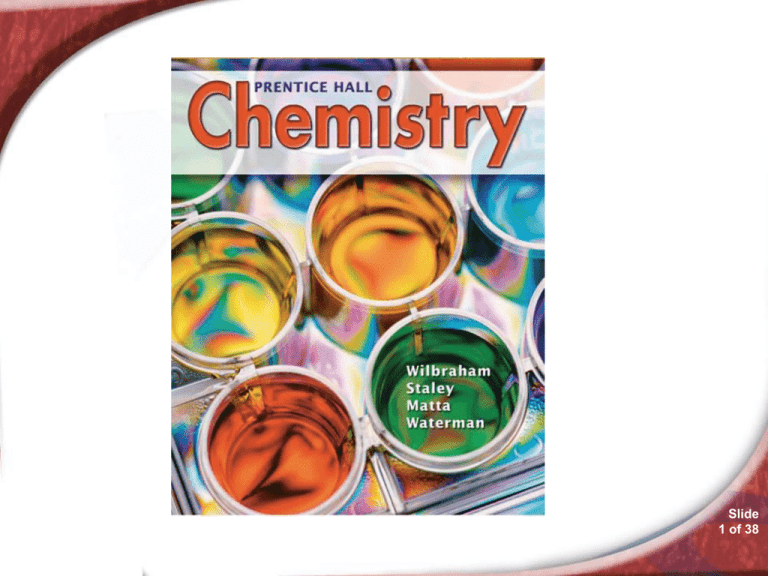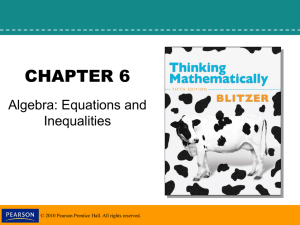
chemistry
Slide
1 of 38
5.3
Physics and the Quantum Mechanical
Model
Neon advertising signs are
formed from glass tubes bent in
various shapes. An electric
current passing through the gas
in each glass tube makes the
gas glow with its own
characteristic color. You will
learn why each gas glows with a
specific color of light.
Slide
2 of 38
© Copyright Pearson Prentice Hall
5.3
Physics and the Quantum
Mechanical Model
>
Light
• The amplitude of a wave is the wave’s height
from zero to the crest.
• The wavelength, represented by (the Greek
letter lambda), is the distance between the
crests.
• The frequency, represented by (the Greek
letter nu), is the number of wave cycles to
pass a given point per unit of time.
• The SI unit of cycles per second is called a
hertz (Hz).
Slide
3 of 38
© Copyright Pearson Prentice Hall
5.3
Physics and the Quantum
Mechanical Model
>
Light
The wavelength and frequency of light
are inversely proportional to each other.
Slide
4 of 38
© Copyright Pearson Prentice Hall
5.3
Physics and the Quantum
Mechanical Model
>
Light
The product of the frequency and wavelength
always equals a constant (c), the speed of light.
c= 2.998 x 108 m/s
Slide
5 of 38
© Copyright Pearson Prentice Hall
5.3
Physics and the Quantum
Mechanical Model
>
Light
According to the wave model, light consists of
electromagnetic waves.
• Electromagnetic radiation includes radio
waves, microwaves, infrared waves, visible
light, ultraviolet waves, X-rays, and gamma
rays.
• All electromagnetic waves travel in a vacuum
at a speed of 2.998 108 m/s.
Slide
6 of 38
© Copyright Pearson Prentice Hall
5.3
Physics and the Quantum
Mechanical Model
>
Light
Sunlight consists of light with a continuous range
of wavelengths and frequencies.
• When sunlight passes through a prism, the
different frequencies separate into a
spectrum of colors.
• In the visible spectrum, red light has the
longest wavelength and the lowest frequency.
Slide
7 of 38
© Copyright Pearson Prentice Hall
5.3
Physics and the Quantum
Mechanical Model
>
Light
The electromagnetic spectrum consists of
radiation over a broad band of wavelengths.
Slide
8 of 38
© Copyright Pearson Prentice Hall
SAMPLE PROBLEM 5.1
Slide
9 of 38
© Copyright Pearson Prentice Hall
SAMPLE PROBLEM 5.1
Slide
10 of 38
© Copyright Pearson Prentice Hall
SAMPLE PROBLEM 5.1
Slide
11 of 38
© Copyright Pearson Prentice Hall
SAMPLE PROBLEM 5.1
Slide
12 of 38
© Copyright Pearson Prentice Hall
Practice Problems for Sample Problem 5.1
Problem-Solving 5.15 Solve
Problem 15 with the help of an
interactive guided tutorial.
Slide
13 of 38
© Copyright Pearson Prentice Hall
5.3
Physics and the Quantum
Mechanical Model
>
Atomic Spectra
A prism separates light into the colors it contains.
When white light passes through a prism, it
produces a rainbow of colors.
Slide
14 of 38
© Copyright Pearson Prentice Hall
5.3
Physics and the Quantum
Mechanical Model
>
Atomic Spectra
When atoms absorb energy, electrons move into
higher energy levels. These electrons the lose
energy by emitting light when they return to lower
energy levels.
When light from a helium lamp passes through a
prism, discrete lines are produced.
Slide
15 of 38
© Copyright Pearson Prentice Hall
5.3
Physics and the Quantum
Mechanical Model
>
Atomic Spectra
The frequencies of light emitted by an
element separate into discrete lines to give
the atomic emission spectrum of the
element.
Mercury
Nitrogen
Slide
16 of 38
© Copyright Pearson Prentice Hall
Physics and the Quantum
Mechanical Model
>
Atomic emission spectrum- the discrete lines formed when
atoms absorb energy, forcing electrons into higher energy
levels and then lose energy by emitting light as the electrons
fall to lower energy levels
The light is made up of only a few specific frequencies,
depending on the element
Each frequency is a different color
The light is emitted as electrons fall from one energy
level to another, like from n=4 to n=1
They are like atomic fingerprints- every element is unique
Slide
17 of 38
© Copyright Pearson Prentice Hall
Physics and the Quantum
Mechanical Model
>
Examples of Atomic Emission Spectra:
http://www.avogadro.co.uk/light/bohr/spectra.htm
Spectrum for barium and hydrogen
http://jersey.uoregon.edu/vlab/elements/Elements.html
http://csep10.phys.utk.edu/astr162/lect/light/absorption.
html
Slide
18 of 38
© Copyright Pearson Prentice Hall
5.3
Physics and the Quantum
Mechanical Model
>
An Explanation of Atomic Spectra
In the Bohr model, the lone electron in the hydrogen
atom can have only certain specific energies.
• When the electron has its lowest possible energy,
the atom is in its ground state.
• Excitation of the electron by absorbing energy
raises the atom from the ground state to an
excited state. (not the orbital predicted by aufbau
chart)
• A quantum of energy in the form of light is emitted
when the electron drops back to a lower energy
level.
© Copyright Pearson Prentice Hall
Slide
19 of 38
Physics and the Quantum
Mechanical Model
>
Atomic Emission Spectra
Light emitted by an electron moving from a
higher to lower energy level has a frequency
directly proportional to the energy change of
the electron
Equation describing energy change of the
electron
E = h x ν (h = 6.626 x 10-34J/s)
So different energy level drops result in different
frequencies (and colors) of light
Slide
20 of 38
© Copyright Pearson Prentice Hall
5.3
Physics and the Quantum
Mechanical Model
>
An Explanation of Atomic Spectra
The three groups of lines in the hydrogen
spectrum correspond to the transition of
electrons from higher energy levels to lower
energy levels.
Slide
21 of 38
© Copyright Pearson Prentice Hall
Physics and the Quantum
Mechanical Model
>
An Explanation of Atomic Spectra
Animation 6
Learn about atomic emission spectra and how
neon lights work.
Slide
22 of 38
© Copyright Pearson Prentice Hall
5.3
Physics and the Quantum
Mechanical Model
>
Quantum Mechanics
Quantum Mechanics
How does quantum mechanics differ
from classical mechanics?
Slide
23 of 38
© Copyright Pearson Prentice Hall
5.3
Physics and the Quantum
Mechanical Model
>
Quantum Mechanics
Remember that both light and electrons
behave as both particles and waves!
Light particles are called photons.
When photons hit metals, they can result in the
ejection of electrons- This is the photoelectric effect
We use this property to create electron
microscopes, which allow for clearer images since
they have smaller wavelengths than light- see page
144
Slide
24 of 38
© Copyright Pearson Prentice Hall
5.3
Physics and the Quantum
Mechanical Model
>
Quantum Mechanics
Today, the wavelike properties of beams of
electrons are useful in magnifying objects. The
electrons in an electron microscope have much
smaller wavelengths than visible light. This
allows a much clearer enlarged image of a very
small object, such as this mite.
Slide
25 of 38
© Copyright Pearson Prentice Hall
Physics and the Quantum
Mechanical Model
>
Quantum Mechanics
Simulation 4
Simulate the photoelectric effect. Observe the
results as a function of radiation frequency
and intensity.
Slide
26 of 38
© Copyright Pearson Prentice Hall
5.3
Physics and the Quantum
Mechanical Model
>
Quantum Mechanics
Classical mechanics adequately
describes the motions of bodies much
larger than atoms, while quantum
mechanics describes the motions of
subatomic particles and atoms as waves.
Slide
27 of 38
© Copyright Pearson Prentice Hall
5.3
Physics and the Quantum
Mechanical Model
>
Quantum Mechanics
The Heisenberg uncertainty principle states
that it is impossible to know exactly both the
velocity and the position of a particle at the same
time.
• This limitation is critical in dealing with small
particles such as electrons.
• This limitation does not matter for ordinarysized object such as cars or airplanes.
Slide
28 of 38
© Copyright Pearson Prentice Hall
5.3
Physics and the Quantum
Mechanical Model
>
Quantum Mechanics
The Heisenberg Uncertainty Principle
Slide
29 of 38
© Copyright Pearson Prentice Hall
Physics and the Quantum
Mechanical Model
>
http://www.teachersdomain.org/resources/phy03
/sci/phys/fund/quantum/index.html
http://www.teachersdomain.org/resources/phy03
/sci/phys/matter/quantumcafe/index.html Quantum Cafe
Slide
30 of 38
© Copyright Pearson Prentice Hall
5.3 Section Quiz.
1. Calculate the frequency of a radar wave with
a wavelength of 125 mm.
a. 2.40 109 Hz
b. 2.40 1024 Hz
c. 2.40 106 Hz
d. 2.40 102 Hz
Slide
31 of 38
© Copyright Pearson Prentice Hall
5.3 Section Quiz.
2. The lines in the emission spectrum for an
element are caused by
a. the movement of electrons from lower to
higher energy levels.
b. the movement of electrons from higher to
lower energy levels.
c. the electron configuration in the ground
state.
d. the electron configuration of an atom.
© Copyright Pearson Prentice Hall
Slide
32 of 38
5.3 Section Quiz.
3. Spectral lines in a series become closer
together as n increases because the
a. energy levels have similar values.
b. energy levels become farther apart.
c. atom is approaching ground state.
d. electrons are being emitted at a slower
rate.
Slide
33 of 38
© Copyright Pearson Prentice Hall
Physics and the Quantum
Mechanical Model
>
Concept Map 5
Concept Map 5 Solve the
concept map with the help of an
interactive guided tutorial.
© Copyright Pearson Prentice Hall
Slide
34 of 38
END OF SHOW







